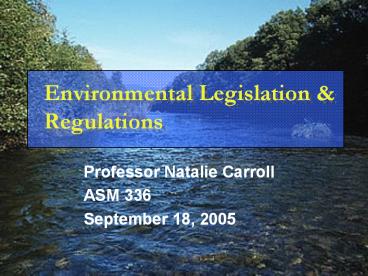Environmental Legislation - PowerPoint PPT Presentation
Title:
Environmental Legislation
Description:
Environmental Legislation & Regulations Professor Natalie Carroll ASM 336 September 18, 2005 Who governs environmental laws and policies? US Environmental Protection ... – PowerPoint PPT presentation
Number of Views:196
Avg rating:3.0/5.0
Title: Environmental Legislation
1
Environmental Legislation Regulations
- Professor Natalie Carroll
- ASM 336
- September 18, 2005
2
Who governs environmental laws and policies?
- US Environmental Protection Agency (EPA) The
governing body for major statues or laws - National Environmental Policy Act (NEPA)-1969
establishes policies, set goals and facilitate
the implementation of such policies - NEPA requires federal agencies to assess
environmental impact of implementing their major
program (Work with NASA Army)
3
Positive Aspects of Regulations
- Protection of the Environment
4
Concerns about Regulations
- Structured so costs excessive compared to
benefits. - Command-and-control
- US Free Market Choice
- Uneven application of regulations
- Lack properly structured incentives
- Generate inefficiencies
- Paper work, costs
- Duplicative (Federal, State, etc)
5
Environmental Regulations
- Clean Air Act (CAA)-1970
- Safe Drinking Water Act (SDWA)-1974
- Clean Water Act (CWA)-1977
- Resource Conservation Recovery Act (RCRA)
-1976 - Comprehensive Environmental Response,
Compensation and Liability Act (CERCLA)-1980 - Federal Insecticide, Fungicide Rodenticide Act
(FIFRA) -1972 - Food Quality Protection Act (FQPA) -1996
6
Clean Air Act (CAA) - 1970
- Diesel Engines
- Odor
7
Safe Drinking Water Act
- Protect nations sources of drinking water
- Protect public health through treatment
techniques - MCLs Maximum Contaminant Level
- Protect underground sources of drinking water
- Well Head protection areas
8
Clean Water Act (1972)
- Water Pollution Control
- Restore maintain chemical, physical and
biological integrity of the nations waters - Community sewers
- NPS pollution control (TMDLs!!!)
- National Pollutant Discharge Elimination System
(NPDES)
9
Resource Conservation Recovery Act (RCRA)
- Hazardous Waste
- Underground tanks
- Control Solid Waste
- Regulation of facilities which burn waste
10
Comprehensive Environment Response, Compensation
and Liability Act (CERCLA)
- Also known as the Superfund
- Establish a Hazardous Substance
- Superfund
- Establish regulations controlling hazardous
waste sites - Provide liability for hazardous waste release
from inactive sites
11
Superfund Amendments and Reauthorization Act
(SARA)-1986
- Revise and extends CERCLA
- Emergency planning preparedness, community
right-to-know reporting and toxic chemical
release reporting - Material Safety Data Sheets (MSDS)
12
Federal Insecticide, Fungicide and Rodenticide
Act (FIFRA)
- Regulates the use and safety of pesticides
products and features - Classification and certification of pesticide by
specific use - Evaluation of risk posed by pesticides (Required
for registration) - Restriction of use of pesticides harmful to the
environment - Enforcement of requirements through inspections,
labeling, notices and state regulations - Groundwater management plan
13
Additional Regulations
- Wild and Scenic Rivers Act
- -establishes wild and scenic river system
- Coastal Zone Management Act (CZMA)
- - balanced preservation development in
coastal areas - Endangered Species Act
- - conserve endangered and threatened species
14
Additional Regulations
- Marine Protection, Research and Sanctuaries Act
- - regulates dumping of all types of materials
into ocean - Toxic Substance Control Act (TSCA)
- - sets up toxic substances program
- - EPA can require manufacturers to collect
data on effects of their substance - National Historic Prevention Act
- -preserve, restore and maintain cultural
resources
15
Additional Regulations
- Occupational Safety and Health Act (OSHA) -1970
- Oil Pollution Act (OPA)-1990
- Endangered Species Act (ESA)-1973
16
- The following slides were taken from a
presentation given by Dr. Thomas L. Theis,
Director of the Institute for Environmental
Science and Policy, University of Illinois at
Chicago. September 13, 2005, Purdue University - Seminar title Environmental Manufacturing
Management A New Approach to Sustainability
17
CONTEXT
- We Have Been Altering the Environment for a Long
Time but are Just Beginning to Take
Responsibility - Environmental Issues are Not Just More Global,
but More Complex - Firms are Increasingly Being Held Responsible for
Environmental and Social Externalities With Which
They are Associated
18
- Sustainability Requires a Different Way of
Thinking About How We Interact Within the
Environment That - Stresses integration of our needs with those of
our progeny - Views the natural world as a constrained system
- Sees humanity as part of a symbiotic relationship
with the world - Recognizes the value of ecosystem services
- Understands the need to make decisions within a
holistic framework
19
(No Transcript)
20
HISTORICAL APPROACHES TO ENVIRONMENTAL MANAGEMENT
ERA TIME FRAME PRIMARY ACTIVITY PRIMARY FOCUS ENDPOINT ENVIRON- MENTAL VS. ECONOMICS CONCEPTUAL MODEL DISCIPLINARY APPROACH
Pre-Regulatory (lt 1965) Past Simple Controls / Burial Specific Site, End-of-Pipe Visual / Navigability Overhead Largely Voluntary Insular -Reductionist
Regulatory (1965- 1990) Past / Present Compliance / Remediation Specific Site, End of Pipe Reduce Anthropo- centric Risk Negative Profit Command-and- control Environmental Sciences / Engineering -Interdisciplinary
Global (gt 1990) Present / Future Industrial Ecology / Design for Environment Materials, Manufacturing, Products, Services Over Life Cycle Waste Minimization / Global Sustainability Strategic Systems Approach Physical / Chemical / Biological Sciences Architecture Law Ethics Urban Planning -Integrative
21
(No Transcript)
22
Traditional (Compliance) Perspective
Final product and residuals measured at the
factory, in terms of materials production.
Residuals Waste pollution
Raw materials
Finished material
Raw materials
23
Systems (Optimization) Perspective
Final product is measured in terms of service,
rather than material, at end of chain rather
than in middle.
Film paper production
Exposure (Capture)
Storage
Film developing printing
Final Product
24
DRIVING FORCES
- Accelerated Costs of Environmental Compliance
- Legislation Focused on Product and Socially
Responsible Stewardship - New, More Efficient Processing Technologies
- Application of Life Cycle Analysis and Total Cost
Accounting - Ability to Measure More Accurately the Impacts of
Waste Emissions
25
USEPA Policy Statement
- to move the Nation from a waste-oriented to a
life cycle management way of thinking about
materials. (USEPA Strategic Plan, 2003-2008, p.
60)
26
QUESTIONS ???































